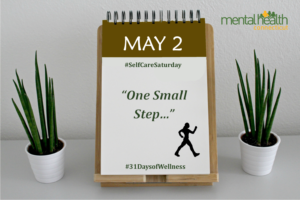Contributed by: Suzi Craig, Chief Strategy Officer, Mental Health Connecticut
 Outside of my work at MHC, I am a certified yoga teacher. Does that mean I’m super zen and chill all the time?
Outside of my work at MHC, I am a certified yoga teacher. Does that mean I’m super zen and chill all the time?
Heck no! It’s quite the opposite.
Yoga is my shield and sword in the sometimes daily battle against anxiety and depression. I’m not always able to Braveheart through a yoga or meditation practice and yell, “FREEEEEEDOM!” at the end, but when I experience the release of things that I don’t need and a greater sense of peace and calm, I always (never fails) say to myself: “the next time you tell yourself you don’t have time for this, remember this feeling.”
Now, let’s talk about you. For some of you, just thinking about making time to learn how to meditate or practice yoga CAUSES stress. I get it. I’ve been there. It can feel daunting or intimidating to start or you’re not sure what to do, or even why you should bother.
I recommend starting small, very small, and find something you think you can do on a regular basis.
And, good news! You only need 10 minutes a day. There are lots of scientific studies out there that have shown that 10 minutes of a meditative practice will help your body heal over the long-run, increasing its ability to lower stress and increase calm.
One place to start, especially during this time of isolation and being #alonetogether, is to take literal small steps with mindful walking. I created a video on why anyone would do this – it can look awkward and weird, afterall—and how to get started, for those who are ambulatory and those who are using a walker or cane:
Essentially, mindful walking is the umbrella term that most folks use when talking about uniting the mind, body, and spirit. The goal is not to arrive at a destination, but to be in the moment through breath work and by taking deliberate steps that are designed to go nowhere except to bring you to a greater sense of calm and connection.
A walking meditation is the way you do it. There are different methods depending on the tradition. Buddhist monks, practitioners in Japan or China, and others have different forms of walking meditations, just like there are different physical practices of yoga.
Think you want to try a sitting meditation or explore other ways to increase wellness through meditative practices? Check out these free and excellent resources:
Ten Percent Happier’s
-
- Live Guided Meditations Every Day at 3pm ET:
https://www.tenpercent.com/live
Greater Good’s Guide to Well-Being During Coronavirus — practices, resources, and articles for individuals, parents, educators, and health care professionals facing COVID-19, and really anytime: https://greatergood.berkeley.edu/article/item/greater_good_guide_to_well_being_during_coronavirus#stress
Office Hours with Dr. Jud –live Q&A for dealing with anxiety: https://www.youtube.com/channel/UCi6bQu-Df7Wh2x3gFT5a8aw
Copper Beech Institute, based in West Hartford, CT has some on-line offerings that are free or invite donation: https://www.copperbeechinstitute.org/upcoming-programs
The Center for Healthy Minds has some great free resources including guided meditations at: https://centerhealthyminds.org/well-being-toolkit-covid19
The Mindful Awareness Resource Center at UCLA is another great resource with practices, resources, and webinars: https://www.uclahealth.org/marc
Be well and best of luck on your journey to less stress and more mindfulness. 😉
#SelfCareSaturdays
#31DaysoWellness
Help MHC reach its goal of raising $31,000 in 31 days! Go to www.mhconn.org/31days to donate or to start your own MHC fundraiser.

